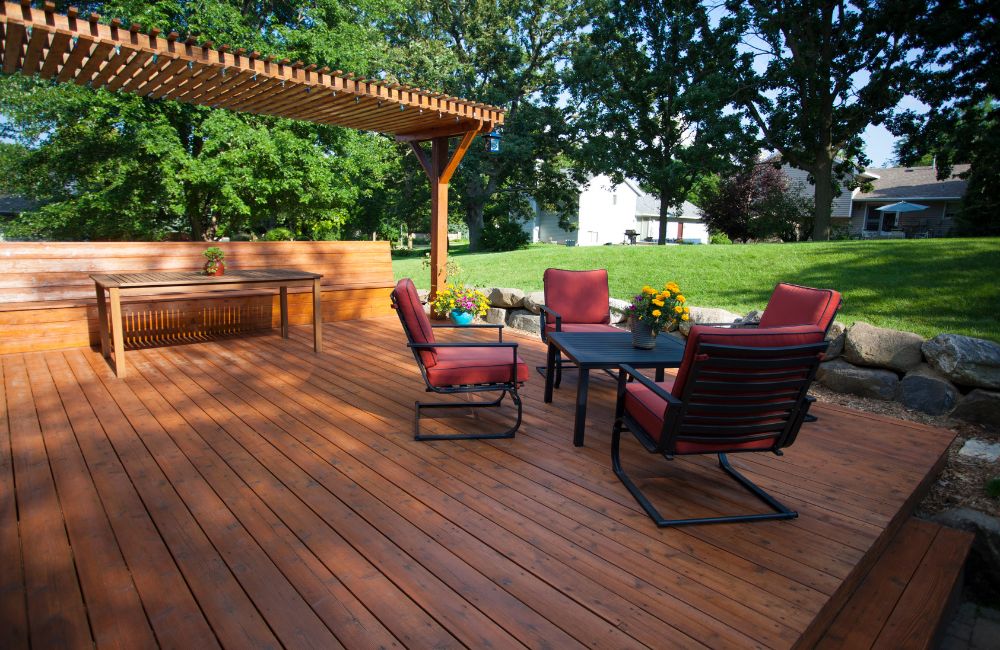Maintaining the stain on your deck might seem like a small task, but it plays a significant role in preserving the beauty and longevity of your outdoor space. Routine maintenance is a great way of saving money, as it helps prevent costly repairs and the need for frequent re-staining. By following a few simple steps from house painters in Westport, CT, you can keep your deck looking fresh and vibrant for years to come. Follow these tips and ensure that your investment continues to pay off in both appearance and durability.

6 Simple Tips to Keep Your Deck Stain Looking Fresh for Years
Keeping your deck stain looking fresh doesn’t have to be a challenge. With these six simple tips, you can easily maintain the beauty and durability of your deck for years to come.
1. Regular Cleaning
Maintaining your deck stain begins with regular cleaning. Consistent upkeep not only preserves the appearance of your deck but also extends the life of the stain. Here’s how to make cleaning an easy and effective part of your deck maintenance routine:
Frequency of Cleaning
To keep your deck looking its best, it’s essential to clean it regularly. House painters recommend a cleaning schedule that aligns with the climate and environment around your home:
- Quarterly Cleaning: For areas with moderate weather, a quarterly cleaning routine will suffice.
- Biannual Cleaning: If you live in a region with harsher weather conditions, house painters often recommend cleaning your deck every six months.
Cleaning Methods
When it comes to cleaning your deck, simplicity is key. You don’t need harsh chemicals or complicated tools—just some basic supplies and a little elbow grease. Here’s a simple method that house painters often recommend:
- Prepare the Cleaning Solution: Mix mild soap with warm water in a bucket. Avoid using anything too abrasive, as it can strip the stain from your deck.
- Scrub the Surface: Use a soft-bristle brush to scrub the deck surface gently. As per house painters, focus on areas that tend to collect dirt, like corners and around deck furniture. The soft bristles are tough enough to remove grime without damaging the stain.
- Rinse Thoroughly: After scrubbing, rinse the deck with clean water. Make sure all soap residue is washed away, as leftover soap can dull the stain.
Tools and Products
Choosing the right tools and products is crucial for effective deck cleaning. Here’s a list of items that house painters often recommend:
- Soft-Bristle Brush: Ideal for scrubbing without damaging the stain.
- Mild Soap: A gentle soap that can clean without stripping the stain.
- Deck-Specific Cleaning Products: There are several products on the market specifically designed for deck maintenance. These cleaners are formulated to be tough on dirt but gentle on stains.
While it’s tempting to use household cleaners, be cautious. Harsh chemicals can strip away the protective stain, leaving your deck vulnerable to damage. House painters advise against using bleach or ammonia-based products, as they can cause more harm than good.
2. Promptly Remove Debris
Keeping your deck free of leaves, dirt, and other debris is essential for maintaining its appearance and longevity. According to professional house painters, debris can trap moisture against the wood, creating an environment where mildew, mold, and staining can thrive.
Over time, this trapped moisture can lead to the deterioration of the deck stain, requiring more frequent reapplications and potentially costly repairs.
Methods for Debris Removal
Regularly clearing your deck of debris is one of the easiest ways to protect your investment. Here are some effective methods recommended by house painters:
- Use a Broom: For smaller decks or light debris, a sturdy broom is a great tool. Sweep the debris off the edges of the deck, ensuring you reach all corners and crevices where debris might accumulate.
- Opt for a Blower: For larger decks or heavy leaf fall, a leaf blower can save time and effort. Blow the debris off the deck, focusing on areas where it tends to gather, such as under furniture or near railing posts.
- Schedule Regular Cleanings: Establish a routine to clear debris at least once a week, or more frequently during the fall when leaves are abundant. House painters recommend this as part of regular deck maintenance.
- Post-Storm Cleanups: After storms or particularly windy days, debris can accumulate quickly. It’s important to remove this promptly to prevent moisture from seeping into the wood. Clearing the deck immediately after a storm can prevent long-term damage and maintain the effectiveness of your deck stain.

3. Inspect and Repair Damage
Regular inspections are crucial to catching potential issues before they become major problems. House painters often advise that you inspect your deck at the start and end of each season. This allows you to spot any damage that might have occurred during harsh weather conditions and address it promptly.
Common Issues to Look For
When inspecting your deck, be on the lookout for these common problems:
- Cracks: Small cracks can develop over time due to weathering and wood expansion. These cracks can allow moisture to penetrate the wood, leading to further damage if not addressed.
- Splinters: Splinters not only pose a safety hazard but can also indicate that the wood is beginning to dry out or degrade. Splintered areas are more susceptible to moisture damage, which can lead to further deterioration.
- Loose Boards: Over time, boards can become loose due to wear and tear or fluctuating temperatures. Loose boards can lead to accidents and further damage to the deck structure if not fixed.
Repair Tips
Addressing minor damage early can save you from larger, more expensive repairs down the line. Here are some tips from house painters for fixing common deck issues:
- Fill Small Cracks: Use a high-quality wood filler or sealant to fill in small cracks. This prevents moisture from seeping into the wood and causing further damage. House painters recommend doing this step before reapplying stains.
- Sand Down Splinters: Sand down splintered areas with fine-grit sandpaper. This not only improves safety but also prepares the surface for staining, ensuring a smooth, even finish.
- Tighten Loose Boards: Secure loose boards by tightening screws or replacing nails as needed. If a board is severely damaged or warped, it may need to be replaced entirely. Consult with professional house painters if you’re unsure about the extent of the repairs needed.
4. Apply UV Protectant
UV rays from the sun can be one of the most damaging elements to your deck stain. Over time, exposure to these rays can cause the stain to fade, lose its vibrant color, and even break down. House painters often recommend applying a UV protectant as part of regular deck maintenance to ensure your deck stays in top condition.
Choosing the Right UV Protectant
Choose a product that offers both UV protection and waterproofing. This dual-action formula will protect your deck from both sun damage and moisture, which can cause warping, swelling, or rot. House painters suggest looking for products labeled as “deck sealers” or “UV-protectant stains.”
Application Tips
Applying UV protectant requires careful attention to detail to ensure even coverage and effective protection. Here are some tips from house painters to help you achieve the best results:
- Prepare the Surface: Before applying the protectant, house painters emphasize the importance of cleaning the deck thoroughly to remove dirt, debris, and mildew. Use a deck cleaner if necessary, and allow the deck to dry completely.
- Choose the Right Time: Apply the UV protectant during a dry period with mild temperatures, ideally in the late spring or early fall. Avoid application in direct sunlight or when rain is forecasted within 24 hours.
- Application Technique: Use a high-quality brush, roller, or sprayer to apply the protectant. Start with the railings and edges, then move on to the deck boards. Apply in long, even strokes, and be sure to follow the wood grain.
- Multiple Coats: According to house painters, you may need to apply multiple coats for optimal protection. Allow each coat to dry according to the manufacturer’s instructions before applying the next.
- Drying Time: After the final coat, let the protectant cure for at least 48 hours before using the deck. This ensures that the UV protectant fully bonds to the wood, providing maximum protection.

5. Reapply Deck Stain Periodically
Even with the best UV protection, deck stains need to be reapplied periodically to maintain their appearance and effectiveness. Most house painters recommend reapplying deck stain every 2-3 years, depending on the climate, amount of sun exposure, and level of foot traffic on your deck.
Signs that your deck needs restaining include fading, chalkiness, or visible wood grain beneath the stain. According to house painters, here are some factors that influence reapplication frequency include:
- Climate: Decks in areas with intense sun or heavy rainfall may require more frequent reapplication.
- Use: High-traffic decks will show wear faster, necessitating more frequent staining.
- Wood Type: Softer woods like pine may need restaining more often than harder woods like cedar or mahogany.
Proper Staining Technique
Proper technique is essential for achieving a smooth, even finish when reapplying deck stain. Follow these steps, often endorsed by professional house painters, to ensure a successful restaining project:
- Surface Preparation: Start by thoroughly cleaning the deck. Remove old, peeling stains with a deck stripper or sander if necessary. Clean the surface with a deck cleaner to eliminate dirt, mildew, and old sealers. Allow the deck to dry completely before proceeding.
- Application: Begin by applying the stain to the railings, spindles, and edges. Use a brush for detailed areas and a roller or pad applicator for larger surfaces. Apply the stain in long, even strokes, working with the wood grain to prevent streaking.
- Avoid Over-application: Apply the stain in thin, even coats. Over-application can lead to a sticky surface or uneven drying, which house painters note can detract from the deck’s appearance.
- Drying Time: Allow the stain to dry fully between coats. Depending on the product, this could take anywhere from a few hours to a full day. Ensure the deck is dry before allowing foot traffic.
- Final Inspection: After the final coat has dried, inspect the deck for any missed spots or uneven areas. As per house painters, touch up as needed to ensure a uniform appearance.
6. Use Furniture Pads
Proper deck maintenance involves not just cleaning and inspecting your deck, but also protecting it from everyday wear and tear. One of the simplest ways to do this is by using furniture pads.
Why Furniture Pads are Essential
Outdoor furniture is a key component of any deck, providing comfort and style. However, as you move chairs, tables, or even planters across the deck, the legs of these items can scratch the surface. House painters emphasize that scratches from furniture are a common issue that many homeowners overlook. Over time, these small scratches can accumulate, compromising the overall appearance and durability of your deck.
Frequently Asked Questions
What are the common mistakes to avoid when staining a deck?
Common mistakes when staining a deck include failing to prepare the surface properly, applying stain too thickly, and staining in unfavorable weather conditions. Skipping the cleaning and sanding steps can lead to poor stain adhesion and an uneven finish. Applying too much stain can cause it to pool and create sticky, blotchy spots that take longer to dry and wear unevenly. Staining when the weather is too hot, cold, or humid can also affect the stain’s ability to dry and cure properly. It’s also important to follow the manufacturer’s instructions and work under the right conditions to achieve the best results.
What can I do if my deck stain doesn’t dry properly?
If your deck stain doesn’t dry properly, it may be due to applying the stain too thickly, using it in inappropriate weather conditions, or applying it over a poorly prepared surface. To address this, first, give it extra time to dry, as it might just need a few more hours or even days, depending on the weather. If the stain remains sticky or tacky after an extended period, you may need to remove the excess stain by wiping it down with a cloth dampened with mineral spirits (for oil-based stains) or soapy water (for water-based stains). In extreme cases, sanding the deck and starting the staining process anew might be necessary.
What should I do if my deck stain fades unevenly?
Uneven fading of deck stain can occur due to various factors, including uneven sun exposure, differences in wood porosity, or applying the stain inconsistently. To fix this, start by cleaning the deck thoroughly to remove dirt and debris that could affect stain adhesion. If the fading is severe, consider sanding the entire deck to create an even surface before reapplying a fresh coat of stain. When reapplying, work in small sections and use a consistent method, such as brushing or rolling, to ensure even coverage. To prevent future issues, maintain the deck regularly and reapply the stain before it starts to show significant signs of wear.
What are the differences between oil-based and water-based deck stains?
Oil-based deck stains penetrate deeper into the wood, offering robust protection against moisture and a rich, natural finish. They are known for their durability and are often preferred for older decks with more wear and tear. However, oil-based stains can take longer to dry and may be more challenging to clean up. On the other hand, water-based stains dry faster, are easier to clean, and have lower VOCs (volatile organic compounds), making them more environmentally friendly. While they may not penetrate as deeply, they still provide good protection and are available in a wide range of colors and finishes.
How can I avoid lap marks when staining my deck?
To avoid lap marks when staining your deck, work in small sections and maintain a wet edge as you apply the stain. Lap marks occur when one area of the stain begins to dry before the adjacent area is stained, leading to uneven color and visible lines. To prevent this, start at one end of the deck and work your way across, applying the stain in long, continuous strokes that overlap slightly with the previous section. If you’re using a brush, roll, or spray, always back-brush the stain to ensure even penetration and remove excess product. Working in the shade and on cooler days can also help by extending the drying time and reducing the likelihood of lap marks.
Post that you may like: Reduce Depression and Anxiety with these 10 Calming Paint Colors Suggested by House Painters
Trust Custom Colonial Painting for Expert Deck Stain Services in Westport, CT!
At Custom Colonial Painting, we know how crucial it is to keep your deck stain looking fresh and vibrant. Our skilled team in Westport, CT, specializes in delivering top-notch deck staining services that will enhance the beauty and longevity of your outdoor space. Whether your deck needs a complete stain application or a touch-up to restore its original charm, we’re here to provide expert craftsmanship with the attention to detail that your deck deserves. Proudly serving Westport, CT, Custom Colonial Painting is dedicated to making your deck look its absolute best.
Contact us today to schedule your deck staining project in Westport, CT!


